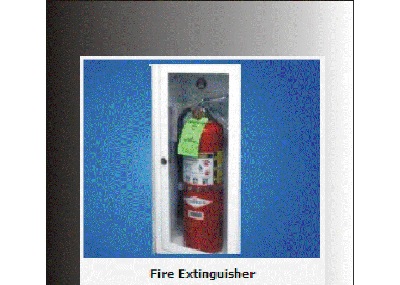


 |
 |
 |
 |
 |
 |
 |
 |
 |
 |
 |
 |
 |
 |
 |
 |
 |
 |
 |
 |
 |
 |
 |
 |
 |
 |
 |
 |
 |
 |
 |
 |
 |
 |
 |
 |
 |
 |

- Potential Hazard:
The potential for fire can occur from many different sources such as: heat-producing equipment, storage of flammable chemicals, and faulty electrical wiring.
Possible Solutions
OSHA Fire Safety requirements include: Adequate exit routes for evacuation during fires and other emergencies [29 CFR 1910.34)].

Employers must provide exit routes in accordance ith OSHA Standard on Exit Routes 29 CFR 1910 Subpart E, including:
§ An adequate number of exit routes [29 CFR 1910.36(b)].
§ Exits must discharge to a safe area [29 CFR 1910.36(c)].
§ Exits must be of adequate capacity and width [29 CFR 1910.36(f) and 29 CFR 1910.36(g)].
§ Exits must be clearly lighted and marked [29 CFR 1910.37(b)].
§ An employee alarm system is provided [29 CFR 1910.37(b)] and complies with 29 CFR 1910.165.
Employers must maintain exit routes in accordance with OSHA Standard on Exit Routes:
[29 CFR 1910 Subpart E]:
§ Exit doors must be unlocked [29 CFR 1910.36(d)].
§ Access to exits must remain free and unobstructed at all times [29 CFR 1910.37(a)].
§ During construction, exit routes must be compliant prior to employee occupancy [29 CFR 1910.37(d)(1)].
§ During repairs or alterations, exit routes must be compliant during employee occupancy or alternate protective measures provided [29 CFR 1910.36(d)(1)].
Alternatives: Employers may use the corresponding provisions of the following codes as alternatives to the Subpart E provisions above [29 CFR 1910.35].
The 2009 National Fire Protection Association (NFPA) Life Safety Code
The 2009 International Fire Code.
Emergency Action Plans: must be provided in accordance with 29 CFR 1910.38 when required by another OSHA standard. See OSHA's Evacuation Plans and Procedures eTool - Emergency Action Plan Page.
§ Must be writing if over 10 employees [29 CFR 1910.38(b)].
§ Elements to include in the plan are listed in 29 CFR 1910.38(c).
Fire Prevention Plans: must be provided in accordance with 1910.39 when required by another OSHA standard. See OSHA's Evacuation Plans and Procedures eTool - Fire Prevention Plan (FPP) Page.
Must be writing if over 10 employees [29 CFR 1910.39(b)].
Elements to include in the plan are listed in 29 CFR 1910.39(c).
Hazardous Materials are used in accordance with 29 CFR 1910 Subpart H, which includes:
Oxygen [29 CFR 1910.104]
Nitrous Oxide [29 CFR 1910.105]
Flammable and Combustible Liquids [29 CFR 1910.106]
Electrical wiring methods, components, and equipment for general use [29 CFR 1910.305].
Fire Brigades: if provided, must meet 29 CFR 1910.156.
Fire Protection Systems: if provided, must meet 29 CFR 1910 Subpart L, which includes:
Standpipe systems [29 CFR 1910.158]
Fixed extinguishing systems [29 CFR 1910.159 through 1910.163]
Fire Detection systems [29 CFR 1910.164]
Employee alarm systems [29 CFR 1910.165]
- Additional Information:
Fire Safety. OSHA Safety and Health Topics Page. Covers general fire safety measures. Fire Safety [55 KB PDF*, 2 pages]. OSHA Fact Sheet. Emergency Exit Routes [71 KB PDF*, 3 pages]. OSHA Fact Sheet.